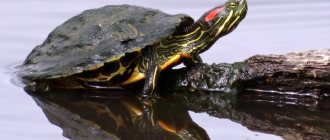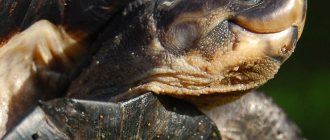In order for a land turtle to feel comfortable at home, it is necessary to create a microclimate for it in the terrarium that is as close as possible to the natural environment. Selection of equipment, diet, temperature, timely prevention of diseases - these factors directly affect the well-being of our reptiles.
Keeping land turtles at home
Newbies who buy a turtle for the first time are always interested in its lifespan. In captivity, reptiles can normally exist next to humans for up to 3 decades. Much of the question of how long land turtles live at home depends on properly organized care for pets. Inexperienced fanciers often allow them to live on the floor of the room and offer the animals indiscriminate food from their table. The predictable result of improperly keeping a land turtle at home is constant injury, poisoning and the pitiful condition of the pet.
How to set up a terrarium for a land turtle?
Most hobbyists keep reptiles in glass aquariums. The land turtle feels great at home in a rectangular tank with a volume of up to 100 liters. It is advisable to leave the front wall of the house for your pet transparent, and cover the side and back walls with painted plastic or a wooden panel. Terrariums for land turtles should be 3 times the width of an adult turtle’s shell so that they can move freely inside.
Equipment for a land turtle terrarium
In solving the problem of how to keep a land turtle at home, much depends on the correct selection of equipment for the terrarium. If you do not control the state of the microclimate inside the aquarium and leave the situation to chance, then the animals may get sick and feel uncomfortable. The list of the most necessary equipment is modest and consists of several items; you do not need to allocate large funds to purchase them.
Equipment for keeping a land turtle at home:
- Ultraviolet lamp – the light from this device helps absorb calcium and vitamin D3. The lamp is placed above the ground at a height of 20-40 cm.
- A lamp with a simple incandescent lamp from 40W acts as a heater, necessary to maintain a comfortable temperature inside the terrarium of about 27-29°C.
- Bath for bathing a reptile - take the size of the vessel so that the water level does not exceed the line of the neck.
- Feeder and drinker - a flat, heavy and stable container with low sides is suitable.
- Thermometer - if you are seriously interested in a land turtle at home, its breeding and maintenance, then buy an electronic device with a remote display or a special aquarium thermometer with a suction cup.
- A hygrometer is a device for monitoring the humidity level in a terrarium.
- Shelter - you can buy a decorative house at a pet store or make it yourself. The design of the structure is not important for a land turtle, but the internal dimensions of the “room” and the entrance holes should not restrict its movement.
Soil for a land turtle in a terrarium
The choice of soil plays an important role in keeping a tortoise at home. In its absence, reptiles quickly wear off their claws, in many cases pets experience deformation of their limbs, and frequent colds occur. There are several types of soil available that make it easier to keep a tortoise, each with its own disadvantages or advantages.
Types of good soil for turtles:
- coconut fiber;
- rounded pebbles with a fraction size larger than the reptile’s head (promotes gradual grinding of the claws);
- hay;
- straw;
- moss (sphagnum, moss);
- a mixture of hay and river gravel.
Poor soil for keeping a land turtle at home:
- stone chips with sharp edges - can lead to injury;
- sawdust is cheap, but gathers dust and often produces unpleasant odors;
- fine sand.
- Earth;
- Styrofoam;
- cat litter - ingestion of granules leads to poisoning of reptiles;
- paper.
Outdoor terrarium
An outdoor terrarium can be much more spacious. First of all, the open housing is suitable for European land turtles
It is important that the terrarium is large enough as turtles need a lot of exercise. Enclosures should face south to ensure turtles get plenty of sun.
But it is advisable to include several shady areas there.
Ideally, if the open enclosure is already covered with weeds, this will allow the turtle to have access to a large supply of food. Otherwise, you will have to feed the animal with special supplements.
The area should be adapted to the size and number of turtles. They also want to choose their own travel route sometimes. Don't forget that the area should be well fenced. A high brick wall is best for this. Make sure the fence you make is high enough because turtles can climb up. They are also good diggers, so consider the strength of the fence near the ground.
The design of the enclosure should contain a variety of zones. To do this, place stones or rocks. After all, turtles like to overcome various obstacles in the fresh air. You can build a small pond
But pay attention to its depth, as turtles cannot swim. You can also decorate the terrarium with a little imagination
If you want to add vegetation to your tortoise's home, make sure that the plants are not poisonous, as there is a good chance that they will try to eat them.
Advice!
If you want to breed turtles, create a small mound in their territory. Females lay eggs on hills or small slopes. Even if the turtle is not laying eggs during this period, this can be used as an excellent sunny place to rest.
Caring for a land turtle
Purchasing equipment and setting up a terrarium is half the battle; you need to be able to create good conditions for a land turtle, provide it with healthy food at home, and care for your pet’s shell. Reptiles need periodic trimming of their nails; in the absence of solid ground, they grow to large sizes and interfere with crawling. You only need to cut off the light edge of the claws, the dark part is alive and there are blood capillaries inside it. Be sure to remove dirt and food debris from the terrarium, removing potential sources of infection.
How to wash a land turtle at home?
Keeping a land turtle at home involves periodically bathing the pet in a small bath. Reptiles under 2 years of age are given water treatments 2-3 times a week; adults are washed less often. We do not pour water into the bath to the brim, only 2/3 of the height of your smallest turtle, so that the liquid does not get into its nostrils. It is dangerous to bathe animals in the shower; sudden changes in water temperature can cause burns or hypothermia.
The optimal water temperature for swimming turtles is about 35°C. For medicinal purposes, instead of tap liquid, some lovers use chamomile infusions. Water procedures last up to 30 minutes, after which we take out the pets and carefully wipe the shell and body with a soft cloth. A land turtle at home is terribly afraid of drafts, so after finishing its bathing, we immediately transfer it to a warm terrarium.
Caring for a land turtle's shell
The main diseases of the shell are chipping, softening and peeling of the plates. This often happens due to the lack of ultraviolet lamps, without which vitamins and other elements in a terrarium closed from the sun are absorbed extremely poorly. The life of land turtles at home is measured, here they are not threatened by predators, but often the owners themselves or their children accidentally drop their pets from a height. Damage is washed with antiseptics and fixed with plaster and polymers. Fungal infections are treated with special creams that are applied to the affected areas.
Food in summer and winter
Summer feeding of land turtles is usually not difficult, because fresh herbs, vegetables, fruits, and berries can be easily picked or purchased.
Food should be prepared for the winter. Greens can be cut and frozen in the refrigerator, dividing them into daily portions. You can do the same with fruits and vegetables. Forbs can also be prepared in the form of hay.
If there are fish in the house, then you can plant an abundance of aquatic plants in the aquarium and feed your land pet with them in winter.
In the terrarium you can also install clay pots in which alfalfa, oats, wheat stalks, plantain, dandelion sprouts, and cultivated varieties of greens grow. All types of land turtles happily eat sprouted carrot tops.
Diet of a land turtle at home
The health of a reptile directly depends on its diet, so the question of what to feed a land turtle in winter or hot summers is vital for your pet. In nature, animals know where succulent herbs grow that can saturate the body with fluid, but at home, nutrition depends solely on the owner. A turtle needs vitamin supplements and calcium for the growth of bones, muscle mass and shell; without these components, pet nutrition cannot be complete.
What to feed land turtles at home?
The ideal diet is one that contains up to 70% green food and vegetables, a quarter of the food at home consists of fruits, the rest comes from protein products and healthy supplements. Mineral nutrition is made from bone meal, crushed shells, glycerophosphate, and carbonates. A turtle needs pure calcium in large quantities; up to 100 g of this substance is needed per 1 kg of animal weight.
What to feed land turtles at home:
- dandelion leaves,
- clover,
- lawn grass,
- spinach shoots,
- salad,
- basil,
- in winter, turtles are offered steamed hay and alfalfa meal,
- vegetables (zucchini, cucumbers, onions with dill, carrots),
- raspberries,
- strawberry,
- cherries with pits removed,
- apples,
- pears.
What should you not feed your land turtle?
Improper feeding of land turtles at home leads to digestive disorders and serious illnesses, so any fan of reptiles must know the list of harmful vegetables, fruits and other dishes. Food that is healthy for humans may not suit your pet at all, interfere with the absorption of calcium, contribute to the development of gout, or cause iodine deficiency.
Prohibited products for turtles:
- poisonous wild or domestic plants - azalea, oleander, spurge, cyclamen, delphinium, potato tops, lilies, jasmine, hydrangea, mistletoe, rhododendron;
- berry seeds;
- citrus fruit zest;
- tomatoes;
- fruits of cruciferous plants;
- celery;
- spicy herbs and garlic;
- ready-made food for other pets;
- fried foods;
- sausages;
- stewed or boiled meat;
- flour products;
- hard cheese or cottage cheese;
- It is forbidden to offer sweet fruits to turtles in large quantities;
- fatty meat and fish;
- poisonous or poisoned insects;
- crickets;
- cockroaches.
How many times a day should you feed your tortoise?
An important question is how often to feed a land turtle, because its health and life expectancy depend on it. We are dealing with diurnal animals, so they are offered food in the morning or at lunchtime. Young animals up to 2 years old are fed once a day, while adults need dense feeding two or three times a week. Do not feed hot foods or very chilled food directly from the refrigerator. We remove the remains of perishable food from the terrarium after three hours so that the turtle does not get poisoned.
How to water a land turtle at home?
Beginners do not always study all the nuances and conditions of keeping land turtles at home, forcing their charges to drink by force. Many species of reptiles have difficulty drinking water in the usual way; it simply flows out without entering the stomach. Turtles consume the bulk of their moisture together with succulent plant foods, absorb liquid through their skin during bathing, and only rarely approach drinking bowls.
Food in natural habitat
In the wild, land turtles obtain their own food. This is, for the most part, plant food - grass, plant roots, berries, algae from the edges of reservoirs. Some part of the diet of wild turtles is protein food. These are worms, small insects, small snails.
The peculiarity of this reptile is that it can remain without food for quite a long time, storing significant reserves of it in its body during favorable seasons.
These animals are well versed in what vitamins, micro- and macroelements they lack at a certain stage of life and successfully find the products they need in the animal and plant world.
Diseases of land turtles at home
Most diseases and injuries occur in animals indoors or outdoors. Outside, they can be injured by dogs, pathogens and worms live in the dirt, and it’s always easy to find leftover junk food on the floor. In the question of how to treat a land turtle at home with potent drugs, a veterinarian or an experienced amateur can help; self-medication with antibiotics or human drugs often aggravates the situation.
Main diseases of turtles:
- Pneumonia - occurs from hypothermia, prolonged living of an animal in a draft. The disease is treated with antibiotics Baytril 2.5%, Oxytetracycline, Ampiox, Enroflon.
- Lack of calcium and vitamin D 3 - rickets manifests itself externally in the curvature of the shell, softening of the plates. In old animals, the shell becomes unnaturally lighter, and the bone plates become porous. Treatment is carried out with injections of Calcium gluconate, drinking Panangin, and adding mineral components to the feed.
- Dermatitis and fungi - sick turtles are removed at home, the shell is treated with peroxide, Lamisil or Nizoral ointment. You can make compresses with napkins soaked in Chlorhexidine.
- Helminthiasis - use Wolbazen, Nemozol, Praziquantel. Be sure to check the dosage of the drug with your veterinarian.
- Renal failure - treatment is carried out under the supervision of a specialist using Hartmann's solution, Calcium borogluconate, Dicynon, Catozal.
What not to do
- Color the shell.
- Allow it to hibernate.
- Give medications without consulting a specialist.
- Accommodate a new resident without quarantine for a month.
- Allow animals to play with the turtle.
- Keep the turtle on the floor.
- Leave without a shelter house.
- Use fabric, cotton wool, or wool instead of primer.
- Place aggressive pets together.
- Constantly feed the same thing.
- Cat, dog, human food.
- Animal food.
Reproduction of land turtles at home
It is always useful for hobbyists to know how land turtles reproduce at home and to be able to independently restore the number of pets. Females mature at 10 years of age, and males are ready for mating at 5-6 years of age. On the eve of wintering, individuals of different sexes are seated. After emerging from hibernation, the temperature inside is raised, simulating the onset of spring, and fresh vegetables are introduced into the food. In a group it is desirable to have up to 2-3 males per female. The fertilized reptile buries its eggs in the sand or lays them on land; the optimal incubation temperature is approximately 25-28°C.
Harmful products
Some plants are harmful to reptiles:
- medicinal plants containing alkaloids;
- poisonous plants of the nightshade and buttercup families;
- dieffenbachia;
- elodea;
- spurge;
- azalea;
- hydrangea;
- daffodils;
- ambulia;
- saffron;
- cyclamen;
- digitalis;
- delphinium;
- lily;
- jasmine;
- lupine.
The following products are contraindicated:
- boiled, fried, boiled food;
- sausages, minced meat, pates;
- citrus;
- tops, root crops of radishes, potatoes and radishes;
- avocado;
- eggplant;
- gooseberry;
- parsley;
- cabbage;
- rhubarb;
- berry, fruit seeds;
- porridge;
- dairy products;
- bread;
- food for warm-blooded animals;
- crab sticks;
- tomatoes.
Products available in limited quantities:
- apples;
- corn;
- radish;
- asparagus;
- squid;
- legumes;
- cereal grains, mustard;
- fatty fish and meat;
- pineapples;
- raspberries, strawberries;
- watermelon and melon;
- locusts, crickets, cockroaches;
- onion garlic;
- basil;
- too sweet fruits and berries.
Walks
In the summer, the turtle must be walked. To prevent the turtle from running away and getting lost, it is necessary to build an enclosure or fence for it. It is very important to deepen the fence a few centimeters into the ground, since turtles like to burrow into the grass or soil.
Despite the slowness of the land turtle, it is easy to overlook and get lost in the grass. Therefore, you should keep an eye on her while walking.
Do not leave your turtle in direct sunlight. She must have a dark or secluded place where she can hide.











